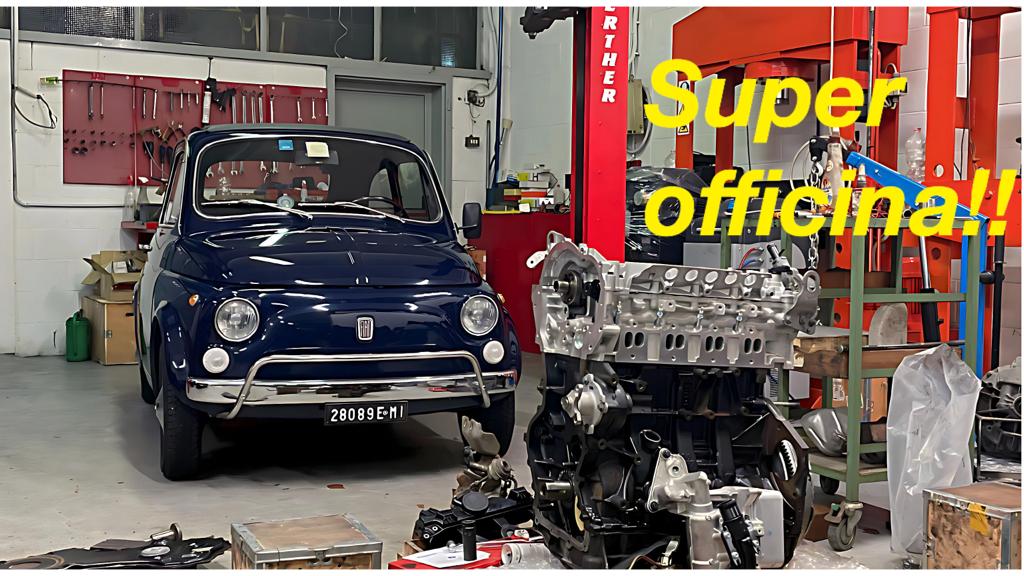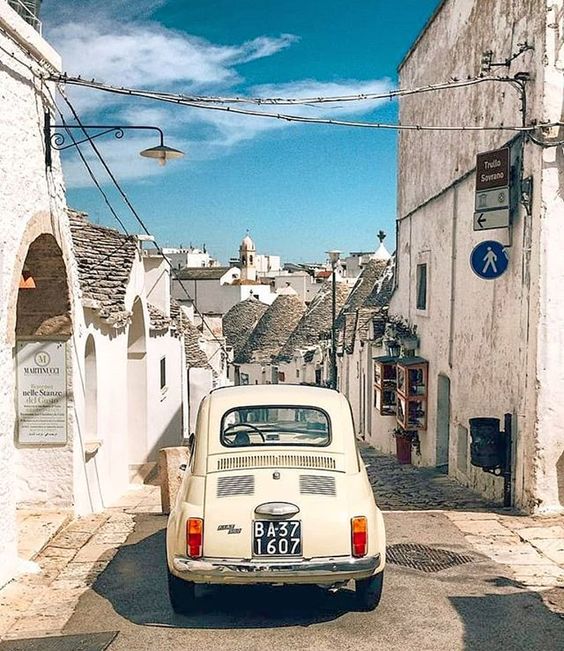La Storia della Fiat 500 in Video: La Fiat 500 L
Diamo oggi inizio ad una nuova serie di articoli basati sui documentari storici disponibili in rete sulla vecchia Fiat 500. Oggi parliamo della Fiat 500 L, la versione più lussuosa e più recente della grande famiglia delle Cinquecento.
Nel 1968 la Fiat inaugura una nuova strategia per rafforzare il già grande successo della vettura. Accanto alla versione “F” viene introdotta la versione lusso, la Fiat 500 L . Questa avrà una grande diffusione. Meccanicamente identica alla “F” la L si distingue per alcune finiture superficiali, tali però da farla considerare davvero lussuosa. All’esterno si notano i paraurti tubolari cromati in aggiunte ai soliti paraurti a lama. Inoltre le guarnizioni dell’unità del lunotto e del parabrezza hanno le rifiniture in plastica ad effetto metallico, così come lungo le grondaie ove è posto un profilo di plastica ad effetto cromo. Sulla calandra, un nuovo logo Fiat di forma allungata, senza baffi, inoltre vengono presentate le nuove nuove tinte con colori originali come, il giallo Positano e l’ocra nero mai apparso su vetture considerate utilitarie. All’interno un nuovo volante in plastica nera di maggiore spessore e con le razze metalliche in vista. Nuovo pure il pulsante del clacson con la scritta Fiat in campo rosso. La plancia viene rivestita di un sottile strato di vinile nero e cambiano anche i rivestimenti sempre tinta unita. Trovano posto alla base delle portiere due pratiche tasche porta oggetti che assolveranno anche alla funzione di maniglie per la chiusura della portiera.
Alla base del cambio è posto un piccolo vano di plastica porta oggetti. Una delle novità più evidenti riguarda l’adozione di un tachimetro di forma rettangolare derivato direttamente dalla sorella maggiore, la Fiat 850. Con questa nuova strumentazione la Fiat 500 L è l’unica delle 500 ad essere equipaggiata di serie dell’indicatore del livello di carburante.
Queste Cinquecento sono così prodotte per quasi tutto il 1972.
Lucio Assente, operaio Fiat intervistato dalla RAI in questo video ci racconta:” Io lavorato alla catena di montaggio della Fiat 500 dal ’68 al ’74. Facevamo circa 700 fiat 500 al giorno, io ero responsabile della direzione selleria, facevamo sedili e pannelli per le porte delle cinquecento e el Capote. La linea correva che faceva paura, se uno per caso si distraeva, per qualche secondo, poi doveva cercare la macchina sui piazzali per completarla, perché la linea non si fermava per nessun motivo. La linea era sacra e intoccabile. Una volta mi hanno fatto il processo: una sera dopo che avevo ripristinato le vetture che erano finite sul piazzale, per tre vetture incomplete, mi hanno chiamato alle due di notte! Era il capo officina per “darmi da bere” C’erano 17 operai solo per montare le Capote del Fiat cinquecento. Da allora io conosco la distinta base della cinquecento, bullone per bullone, pezzo per pezzo…
Gli anni 70 portano in Italia grandi cambiamenti culturali e sociali come pure arriva la prima vera crisi economica del dopoguerra. Alla Fiat si pensa che i tempi siano ormai maturi per lanciare una nuova modello di piccola vettura con il nome di Fiat 126 e anche il pubblico sembra preferirla alla cinquecento. La Fiat decide allora di spostare la produzione della cinquecento prima, presso l’Autobianchi di Desio e poi definitivamente in Sicilia a Termini Imerese, in provincia di Palermo. La straordinaria avventura della produzione di serie della cinquecento si chiude con il modello Fiat 500 R il 1 agosto 1975, con l’ultimo telaio che porta inciso il numero 5231518
E’ con questi numeri che la Fiat cinquecento entra nel mito e nella storia, una storia di un mito che continuano a crescere negli anni trovando appassionati sempre più numerosi e cultori sempre più innamorati. Oggi dopo cinquant’anni e più di di 5 milioni di esemplari di cinquecento prodotte, oltre 600.000 sono ancora in circolazione. Possiamo quindi concludere affermando che molte vetture Fiat ha avuto grandi successi commerciali ma, nessun’altra vettura Fiat ad oggi ma ha ottenuto lo stesso successo affettivo e di pubblico del piccolo cinquino.
Let's start today with a new series of articles based on historical documentaries available on the net on the Fiat 500. Today we talk about the Fiat 500 L, the most luxurious and newest version of the great family of the sixteenth century. In 1968 the Fiat inaugurates a new strategy to strengthen the already very successful coach. Next to the "F" version is introduced the luxury version, the Fiat 500 L. This will have a big spread. Mechanically identical to the "F" the L version is distinguished by some surface finishes, such though it considered truly luxurious. Outside you can see the bull bars in chrome added to the usual bumper blade. Also seals the unit's rear window and windshield have finishes in plastic metallic effect, as well as along the eaves where it is placed a plastic profile with chrome effect. On the grille, a new logo Fiat elongated, without mustache, also discusses the new new colors with the original colors as the yellow ocher and black Positano ever on cars considered utilitarian. Inside a new steering wheel black plastic thicker and with metal spokes in sight. New well the horn button with the word Fiat in red field. The dashboard is covered with a thin layer of black vinyl and also change the coatings always solid. They are placed at the base of the keeper two practices pockets for objects that will fulfill also the function of handles for closing the door. At the base of the gearbox it is placed a small compartment plastic objects. One of the most obvious concerns the adoption of a speedometer rectangular derived directly from the older sister, the Fiat 850. With this new equipment the Fiat 500 L is the only one of 500 to be fitted as standard level indicator fuel. These Cinquecento are thus produced for most of 1972.Lucio Assente, Fiat worker interviewed by RAI in this video tells us: "I worked on the assembly of the Fiat 500 from '68 to '74. We were about 700 fiat 500 a day, I was the manager of upholstery, seats and panels did for the doors of the five hundred and El Capote. The line that ran scared if one happened to be distracted for a few seconds, then had to look for the machine on aprons to complete, because the line would not stop for any reason. The line was sacred and untouchable. When I did the process: one evening after I had restored the cars were finished in the yard for three cars incomplete, they called me at two in the morning! It was the foreman for "give me to drink". We were only 17 workers to assemble the Fiat Capote five. Since then I know the bill of five hundred, bolt to bolt, piece by piece ... The 70 big lead in Italian cultural and social changes as well as get the first real economic crisis of the postwar period. Fiat is thought that the time is now right to launch a new model of small car as the Fiat 126 and the audience seems to prefer it to five. Fiat decides to move production of the first five hundred, at the Autobianchi Desio and then finally in Sicily Termini Imerese, near Palermo. The extraordinary adventure of the series production of five ends with the Fiat 500 R 1 August 1975, with the last frame engraved with the number 5231518. With these numbers that Fiat five hundred members in myth and history, a history of a myth that continues to grow over the years finding more and more fans and lovers always more in love. Today, after fifty years and more than 5 million copies of five produced, over 600,000 are still in circulation. We can therefore conclude that many cars Fiat has had great commercial success, but no other car Fiat today but got the same success and emotional audience of small "Cinquino".
Gli ultimi articoli pubblicati su Fiat 500 nel mondo
Comprare o Vendere una Fiat 500 d’epoca: solo per veri appassionati!
Fiat 500 N – siamo arrivati a 60.000 Euro
In giro per Roma con la Fiat 500!
Orologio Fiat 500: una vera chicca per i cinquecentisti!
Manuale online uso e manutenzione Fiat 500
500 Miglia con le nostre Fiat 500 !!!
La prova di durata della Fiat 500 del 1958 (seconda parte)
Fiat 500 L : The most elegant Cinquecento
Arriva il modello della Fiat 500 da tenere in casa!
Cinquecento immagini!
La prova di durata della Fiat 500 del 1958: la sfida che fece la storia
Restauro della Fiat 500 – Scoprire di che modello si tratta – La Fiat 500 F
My500instatour: In giro per le colline senesi a bordo di Fiat 500 d’epoca
Instatour – Un weekend in giro tra Siena, il Chianti e le Crete senesi a bordo di tre Fiat 500 d’epoca.
La sfida che ha fatto la storia della Fiat 500 d’epoca
L'officina per le vostre Fiat 500 d'epoca

Raramente ho trovato tanta cura e passione come in questa officina. Ne parlo in questo articolo. Se siete vicino a Milano e vi serve una squadra di bravissimi meccanici per la vostra Fiat 500 d'epoca questo è il loro contatto: tel +39 338 776 7046, Via Fanfulla da Lodi, 01, Trezzano sul Naviglio, MI

























500 L la mia prima macchina personale. Fresco di patente, mi sono identificato in questo piccolo “gioiello” che considero ancora tale.